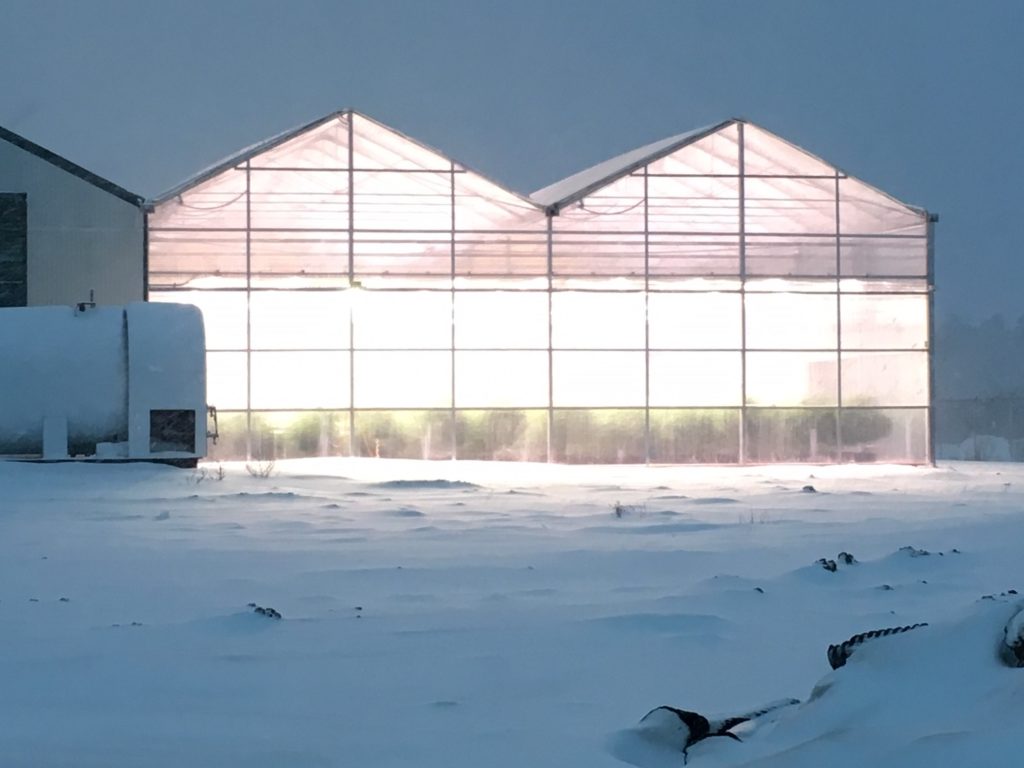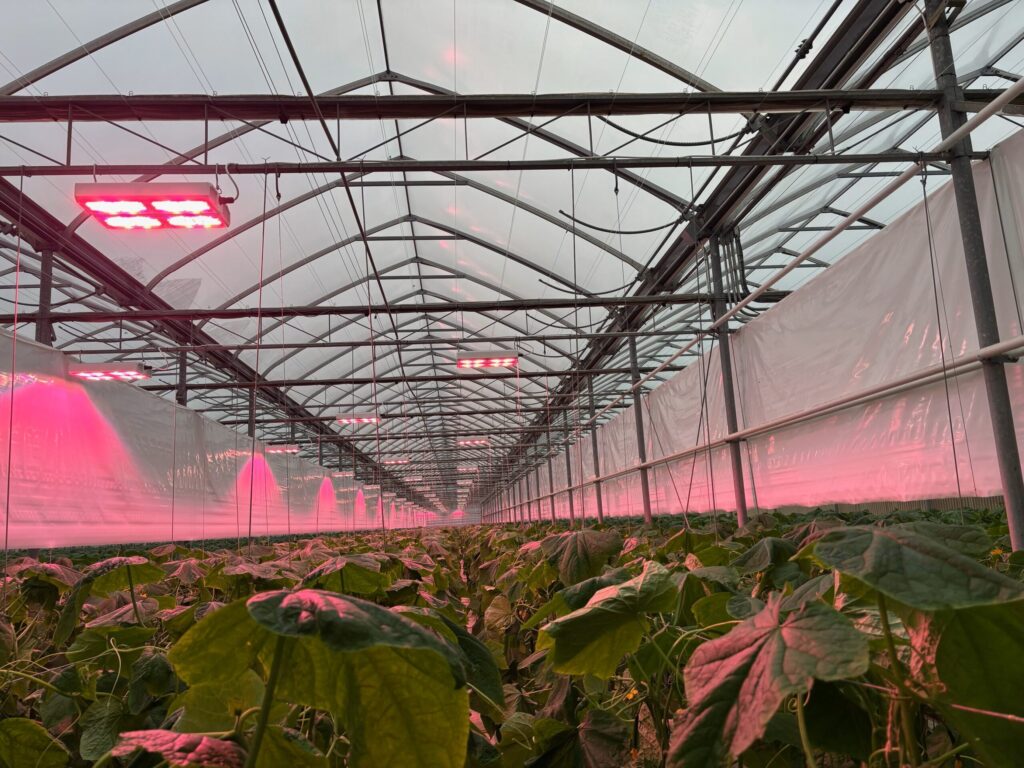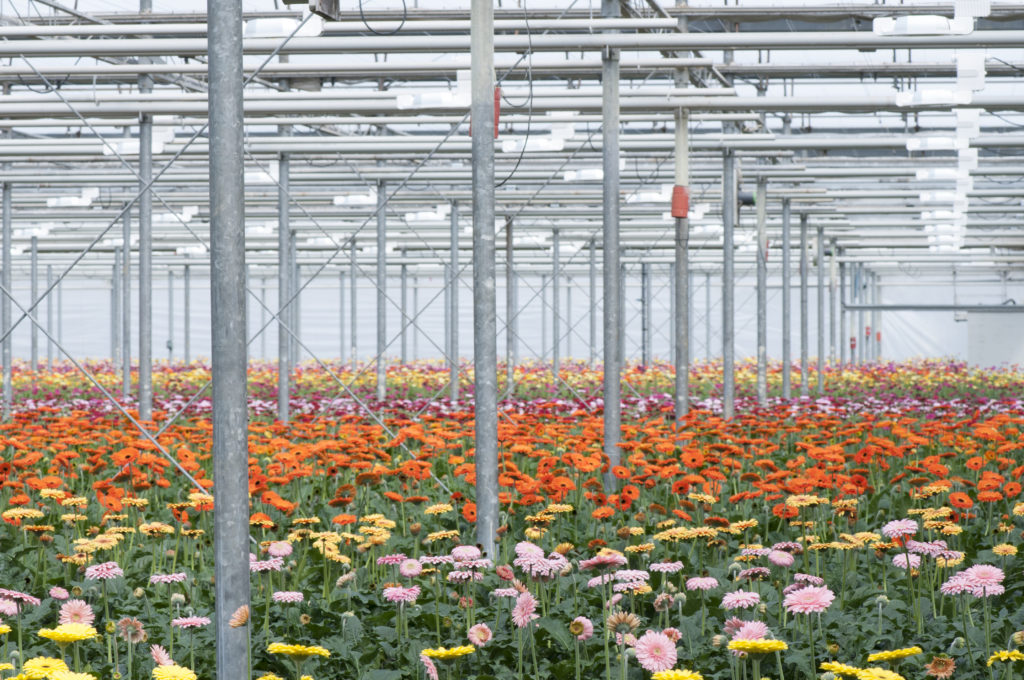One of the limiting factors for winter greenhouse production is low light levels, this is especially important for growers at Northern latitudes who can experience both limited light intensity and photoperiod. Those who are growing crops at northern latitudes need to take special consideration for how they will plan year-round growing. Since we work with many growers who face the challenges of growing in a northerly climate, we have compiled some considerations when deciding on their lighting options.

Let’s Talk DLI (Daily light integral)
What you are growing will help to decide the amount of recommended light intensity and light duration you will need for your crop to get a healthy and productive harvest. DLI or Daily light integral is the number of photosynthetically active photons (in the PAR range of 400-700 nanometers) accumulated in a square meter over the course of a day – in a broader sense it is the amount of photosynthetic light delivered to plants each day. It is usually expressed as moles of light per square meter per day and is a function of light intensity and duration. DLI affects plant quality, photosynthesis rate and plant growth. DLI will change throughout the year and will be higher in the summer and lower in the winter, variations will change depending on your geographic location. The maximum DLI we can receive in the outdoors is about 60 mol/m2/d1 on a cloudless summer day and on a dark winter day, in a northern latitude like Alberta, the outdoor DLI can be less than 5 mol/m2/d1. It’s important to recognize that even though greenhouse structures appear to be “clear” or “transparent” light transmission is usually only between 40-65 percent therefore daily light integrals inside the greenhouse are usually much lower than what is recorded outside. This is due to building materials, glazing, shade structures and other materials and environmental factors.
In general, plants are categorized into several groups: low light plants such as ferns and orchids, medium-light plants such as shade-tolerant bedding plants and leafy greens, and high light plants like full sun bedding plants, cut flowers and fruiting vegetables. Plants such as tomato, pepper, cannabis and roses are recommended to have very high daily light integrals for quality production and yield. For example, if you have less than 5mol/m2/d1 you would need to supplement up to 30mol/m2/d1 for cannabis as it can require up to 35mol/m2/d1.

While suggested DLI varies depending on crop – this guide from Purdue University outlines minimum and recommended DLI for many popular greenhouse crops. Aside from low light plants such as ferns or orchids, many medium and high-light crops will see quality and yield increase with increasing DLI. Plants receiving low daily light integrals tend to be of lower quality and will stretch in search for light.
HPS vs LED for Northern Growers
Lighting is one of the most important factors for growers in a Northern climate where winter light levels are low. Choosing the right lighting system that works with your growing space is imperative to ensuring a successful crop.

LEDs have been shown to save money in the long run by cutting down on electrical costs as well as having a longer life when it comes to burning hours and replacement. However, in many cases we find growers who are located at Northern latitudes continue to use HPS (high pressure sodium) lights in their crops. A reason for this is that LEDs do not emit as much heat as HPS lights, and many plants such as peppers, cannabis and tomatoes tend to benefit from the radiant heat emitted by the HPS lamps in the winter. The heat emitted from the lamps is not an efficient way to heat a greenhouse, but the radiant heat provides a great benefit to the plants. Please take note that you cannot rely on HPS lamps to heat a greenhouse, but they can help cut down on costs.
On the other hand, LEDs while energy efficient, do not emit radiant heat, therefore more heating is required during the winter months to compensate and the heating costs can outweigh the energy savings of the luminaires themselves. Another factor to take into consideration is light uniformity. This depends on how your greenhouse is set up but in general HPS lamps will provide a broader, more uniform light output pattern and LEDs tend to have a more focused illumination. Since we manufacture and sell both HPS and LED luminaires, we do not have a bias towards either and are motivated only to sell you the best lighting system that works for your greenhouse.
Spectrum and Intensity Considerations
Plants require light in the photosynthetically active radiation (PAR) range of 400-700 nanometers for proper development – and not all lights are created equal when it comes to PAR and light quality. When thinking about adding LEDs to your growing operation we recommend starting with a trial area, so you know what to expect if you decide to adopt the lighting on a larger scale. We have worked with growers in the past who have installed a competitor’s LED system, to have them come back and buy additional luminaires from P.L. Light Systems because their existing lights did not have the full spectrum the plants needed and/or the light intensity was not enough to hasten the plant’s growth. Plant varieties will all react differently to variations in light spectrum and light intensity and it’s important to understand what these reactions and outcomes are before investing in lighting for an entire greenhouse.

Considerations for when choosing a lighting system
Many things should be taken into consideration before investing in a lighting solution. Consider how lighting might affect the environment of a greenhouse and any changes that will need to occur. Parameters such as watering, heating, nutrient uptake and humidity may be affected and need to be adjusted.
Some crop and environmental considerations to think about when choosing a lighting system:
- What is your target DLI for your crop?
- This chart from Purdue University gives recommendations of DLI based on crop. By deciding what your target DLI is you can better choose the amount of light you will need to reach your target
- What is your photoperiod for your crop?
- You may need day extension (photoperiod) lighting depending on what you are growing and their photoperiod requirements (long day, short day or day neutral plant varieties).
- What is your temperature range for growing your crop? In general, temperature helps drive the plant development rate.
- Are you growing cold tolerant crops like greens or heat loving crops like tomatoes? Figuring out your target temperature for plant growth can help decide what lighting solution works best for your space
- Where are you growing your plants? How far will the lights be to your plants? This information can help decide light distribution and uniformity over the crop
- Are they on benches?
- Are you growing plants on the floor or in hanging baskets?
- Are they being grown in a vertical system?
- What materials are the greenhouse made of? How much light gets emitted and absorbed by the plants?
- How are you watering your plants? The type of lighting you chose will affect your irrigation schedule. In general, plants grown under HPS lamps require higher amounts of water. Using flood tables or drip irrigation can help control watering and prevent water loss.
- Are you injecting CO2?
- Natural winter CO2 levels can drop in the greenhouse. In general, CO2 enrichment will increase the photosynthesis rate in plants and will have a positive effect on quality and yield.
- Are you using energy curtains in the winter to save on heating costs?
- While a good way to save on heating costs, the curtains can decrease the amount of light being transmitted and should be considered when calculating winter DLI and creating a light plan.
- In some cases, lighting may affect nutrient uptake and may lead to deficiencies or excess amounts of certain macro- and micro-nutrients.
- Keeping an eye on pH, EC and getting timely nutrient analysis’ done may be helpful in figuring out a nutrient management program under some artificial lighting

How P.L. Light Systems can support you
We have an experienced team of lighting professionals that can provide light measurements to help understand your greenhouse DLI to make sure your crops are getting the amount of light they require. We can assess your supplemental lighting needs and help determine the best solution for your application though understanding the pros and cons of the different lighting types. For more information contact us or get started with a lighting plan.


